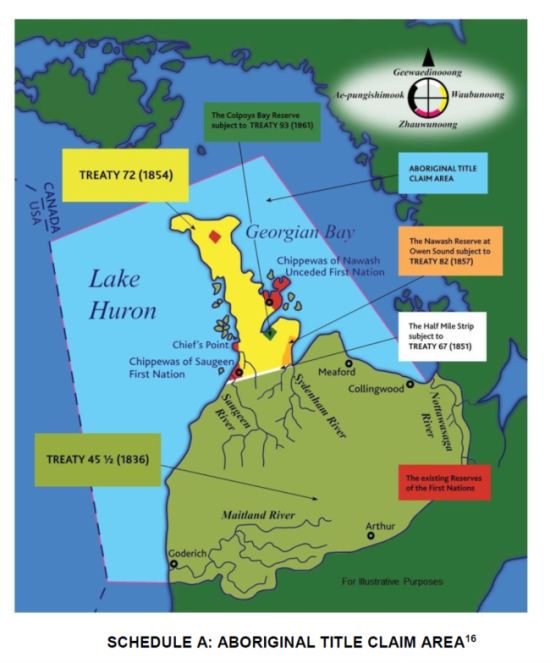- within Insurance topic(s)
- with Senior Company Executives, HR and Finance and Tax Executives
- with readers working within the Business & Consumer Services, Insurance and Healthcare industries
Recently, the Ontario Court of Appeal issued a decision confirming that the test for claiming Aboriginal title over land covered by water (in this case Lake Huron and Georgian Bay) is the same as the test for land generally set out by the Supreme Court of Canada in Tsilhqot'in Nation v. British Columbia 1.
The Chippewas of Nawash Unceded First Nations and the Saugeen First Nation — which refer to themselves together as the Saugeen Ojibway Nation, or "SON" — had sued the Canadian and Ontario governments for a declaration of Aboriginal title to submerged lands under a large section of Lake Huron and Georgian Bay. They were unsuccessful at trial, and in Chippewas of Nawash Unceded First Nation v. Canada (Attorney General), the Court of Appeal rejected most of their grounds of appeal (and granted an appeal allowing a number of municipalities out of the litigation). However, the court left the door slightly ajar for SON, remitting the matter back to the trial judge to determine whether title can be established in a more limited area, applying the test from Tsilhqot'in. 2
The Chippewas case is significant for confirming that the test for Aboriginal title, as set out in Tsilhqot'in, 3 applies to submerged lands (this was a novel issue at trial). The Court of Appeal found that the trial judge's alternative consideration of the test for the establishment of an Aboriginal right was unnecessary, as "[t]he Tsilhqot'in test is sufficiently flexible to be adapted to a claim for submerged lands." 4
The court addressed the key elements of the test as follows:
To sufficiently occupy the land for the purposes of title, the Aboriginal claimant group must show that it has historically acted in a way that would communicate to third parties that it held the land for its own purposes. The occupation cannot be purely subjective or internal. There must be evidence of a strong presence on or over the land claimed, manifesting itself in acts of occupation that could reasonably be interpreted as demonstrating that the land in question belonged to, was controlled by, or was under the exclusive stewardship of the claimant group ... 5
The trial judge found that SON had not provided evidence that could establish Aboriginal title to the entire area claimed — the "Aboriginal Title Claim Area" a massive area that can be seen in light blue on this map from the decision 6:

In making this determination, the Court of Appeal showed deference to the trial judge's factual findings, as the case had involved a considerable evidentiary record. The court also reviewed a number of issues raised by SON and dismissed SON's arguments that the trial judge had erred in applying this test in the context of submerged lands by, among other things, (1) failing to take into account the submerged nature of the lands at issue; (2) setting too high a threshold for the "control" element of the Tsilhqot'in test in this context; and (3) misperceiving the relationship between Aboriginal title and the common law regarding navigable waters. 7
SON was successful, however, in persuading the Court of Appeal to remit the issue of whether Aboriginal title could be established in a smaller area. On this point, the Court of Appeal cited Tsilhqot'in for the proposition that "a technical approach to pleadings should not stand in the way of resolving the substance of the issues." 8 The Court of Appeal concluded that SON should not have to commence a new proceeding to resolve the issue of a more limited Aboriginal title, and that the trial judge was "uniquely qualified" to do so and could "devise a procedure" for determining whether the Tsilhqot'in test was satisfied in a smaller area. 9
Three other issues of interest were raised and dealt with by the court:
1. Navigation
The Court of Appeal found that whether or not Aboriginal title was compatible with the common law right of public navigation could not be assessed in the abstract, but rather was dependant on the characteristics of established title claims, and left this issue to be determined in the event SON was successful in establishing title. 10
2. Municipalities
SON had also sued a number of municipalities, claiming a constructive trust upon the roads and road allowances within those municipalities. This equitable remedy was rejected by the Court of Appeal as being incompatible with the type of relationship established by the treaties. The court noted, "[a]s acknowledged by SON, the municipalities are utterly innocent of any wrongdoing" 11 and as a result, found that compensation from the Crown as opposed to a constructive trust over municipal lands, was the appropriate remedy. As a result, the claims against the municipalities were dismissed. 12
3. Interpretation of Treaties 45 ½ and 72
The court discussed the history of Treaties 45 ½ and 72. The trial judge had concluded that the Crown had breached Treaty 45 ½ and the Court of Appeal concluded that "arriving at her conclusion that the Crown breached its honour by failing to act diligently, and thereby breached Treaty 45 ½, the trial judge cited and applied the correct legal test and did not misapprehend the evidence." 13 However, the court found that breach of this treaty promise did not amount to a breach of fiduciary duty, and that the honour of the Crown was not breached during Treaty 72 negotiations. 14
4. Ontario's Claim of Immunity from Beach of Fiduciary Duty
Ontario made a number of arguments based on legislation that Ontario is immune from claims by First Nations regarding breaches of fiduciary duty. The Court of Appeal characterized these claims as "a technical approach, which is quite inconsistent with the honour of the Crown" 15 , concluding, "[i]f SON's claim for damages for breach of the Crown's fiduciary duty respecting Treaty 45 ½ were successful, then, in our view, Ontario would not be able to rely on the principles of Crown immunity as a full defence." 16
Conclusions
As a result of the novelty of a claim of Aboriginal title to submerged lands, this case may eventually proceed to the Supreme Court of Canada. Anyone interested in Aboriginal title should continue to follow the Chippewas case. If SON is successful in establishing Aboriginal title over a more limited area of the initially claimed land, we will receive precedent-setting analysis on, among other things, the interaction between the public right of navigation and Aboriginal title to submerged land. If SON is not successful, then the case will still be an interesting example of the application of the Tsilhqot'in analysis applied to submerged lands.
Footnotes
1. Tsilhqot'in Nation v. British Columbia, 2014 SCC 44.
2. 2023 ONCA 565 [Chippewas].
3. 2014 SCC 44.
4. Chippewas at para. 26.
5. Chippewas at para. 15.
6. Saugeen First Nation v. The Attorney General of Canada, 2021 ONSC 4181 at paras 13, 587.
7. Chippewas at para. 19
8. Chippewas at para. 101.
9. Chippewas at para. 107.
10. Chippewas at para. 100.
11. Chippewas at para. 290.
12. Chippewas at para. 298.
13. Chippewas at para. 155.
14. Chippewas at paras 162, 203.
15. Chippewas at para. 249.
16. Chippewas at para. 250.
The content of this article is intended to provide a general guide to the subject matter. Specialist advice should be sought about your specific circumstances.




